Viruses are not always enemies
“A piece of nucleic acid surrounded by bad news,” this is how the virus was defined by Nobel Prize winner Peter Medawar. It is not the most concrete definition, but it is a good example of our vision of viruses, or what we have had for many years. “At first glance we don’t see them very well: they produce diseases, some very serious, 15% of cancers can be caused by viruses, etc.”, explains the microbiologist of the University of Navarra, Ignacio Lopez-Goñi. “But as you dig deeper into the world of viruses you realize that it is an exciting world. Viruses are probably much better than we think.”
“It must be thought that there is a large number of viruses in the world, it is calculated around 10 31 and that of those millions and millions only a few are pathogens,” explains Miren Basaras Ibarzabal, microbiologist of the UPV. “Therefore, many can be hypothetically beneficial. But we still do not know what the majority do.”
It is becoming increasingly clear that viruses have played an important role in the evolution of life. In fact, “viruses are systems capable of exchanging genetic information between cells,” says Lopez-Goñi. “Many times it is discussed whether viruses are living beings and I don’t know how to respond to it either, but surely from the first moments of the genesis of life there were viruses there and have served to increase genetic diversity. Viruses are the engine of evolution.”
Focus on evolution
There are many indications of this in our genome. The genome is plagued by viral sequences called endogenous retroviruses. They are considered to be fragments of DNA from those who have been viruses. Thus, 8% of our genome could come from virus. In general, they have already lost the ability to create viruses, but they can have many other functions. Some offer resistance to other viruses and many others are regulators of our genes.
More and more data show that it is possible that a virus of this type has allowed to develop the lime so important for mammals. When the embryo is installed in the uterus, some cells of the embryo begin to form lime. Among these cells, those that directly touch the uterus produce a protein called syncytin. It is essential for the correct development of the relationship or border between the tissues of the mother and those of the embryo. Because the cytin gene is almost equal to the env gene of viruses. Viruses use the protein that encodes this gene to fuse the host cell with the membrane.
Recently, another study has shown that this type of endogenous retrovirus can also be key in the evolution of the immune system. And similar examples are being drawn constantly. For example, at the beginning of the year, two research groups published that some of the microbes used to send information from the neuron to the neuron are actually very similar to viruses. These microbes, which carry inside the protein Arc, have been able to verify that in the mouse are generated connections between neurons that affect the memory in the long term. Well, the Arc gene is very similar to the gag gene used by viruses to form the capside.
Virus Friends Friends Virus
It is partly clear that we are thanks to viruses. “We are also seeing that viruses directly confer certain capabilities to the host. For example, in bacteria we have known for a long time that certain toxins are produced by viruses. And there are similar examples in plants and animals,” explains Lopez-Goñi.

Few plants are able to grow in the warm lands surrounding the geisers of Yellowstone. On the contrary, the herb dichanthelium lanuginosum is common in these areas. This herb is colonized by a fungus while being infected by a virus. Because the symbiosis between the three is essential for the grass to live on lands close to 50ºC. And by creating symbiosis between this virus infected fungus and tomatoes and other plants in the laboratory, they have seen that they acquire the capacity to live in very hot lands (up to 60ºC).
Even one of the biggest enemies of our apple trees, the fragile phylum (the Dysaphis plant), is accompanied by a virus. By infecting viruses, lice develop the wings. The winged lice are smaller and have less fecundity than those not infected, but greater expansion capacity. The virus passes from one site to another through the plant. Unable to reproduce in plant cells, there will be very few viruses in the plant and the wingless lice will multiply at full speed. As it increases, however, it increases the possibility of infecting lice with viruses in the plant. Thus, when there are too many cloths in the plant, the winged lice that can go in search of another branch or plant will be created again.
Microbiome also virus virus
Humans also have a lot of virus. Our bowels, for example, are full of viruses. “The microbiome is researching a lot and we know that bacteria have an important role, but it seems that in this microbiome viroma is also very important,” explained Basaras. “For example, it has been seen that if the balance of viroma is lost, intestinal inflammatory diseases appear.”
Many of the viruses we have in the intestine are phages, bacteriophages, bacteria viruses, and it is possible that they contribute to regulate the populations of intestinal bacteria, as well as regulating some genes of bacteria important for our digestion. “It has also been seen that some phages can modulate or stimulate the immune response, for example, helping to create antibodies,” explains Basaras.
In addition to the intestines, in general, the mucous of the body are very rich in phages. In our dental mucosa, for example, there are 40 times more viruses than in the skin of the dentures. It is the first line of defense against invasive bacteria in the nasal mucosa, mouth, eyes, the entire digestive tract and even lung. The tissues of human lung grew in the laboratory and saw that in this defensive line the viruses are essential. The normal tissue, and the tissue that had silenced the genes to form the mucosa (without mucous membranes), grew and when adding the bacteria observed that the cells of both tissues died the same, that the mucosa did nothing. Subsequently, antibacterial phages were introduced before the bacteria, in which case the advantage of the mucosa was enormous. In addition, they have seen that fagos contain molecules such as antibodies to grasp the mucosal molecules. This suggests a coevolution of mucosa and fagos.
The mucous membranes are very frequent in the animals and in the mucous of all the animal species analyzed, large amounts of fagos have been found. They are a good example of symbiosis between animals and viruses.
More than Fagos
But it seems that, in addition to phages, other viruses can also provide benefits. In the mouse, it has been observed that when intestinal bacteria are damaged (by taking antibiotics, for example), noroviruses fulfill their beneficial functions, contributing, among other things, to the maintenance of the normal structure of the intestine and the immune system. In the mouse it has also been observed that some viruses help to combat other pathogens. Herpesvirus gamma increases resistance to bacteria Listeria monocytogenes and Yersinia pestis. And the NK lymphocytes, very important in the immune system, thanks to the virus latent herpesvirus, acquire the cells infected by virus and the toxic weapons used to kill tumor cells.

On the other hand, the effects of coinfections can be interesting, as Lopez-Goñi explained: “When you sometimes have a virus infection, a second virus can make things worse, but also vice versa. Some viruses can protect themselves from infections with other viruses, acting on the immune system.”
Although GBV-C slightly slows down the immune system, it does not cause disease. On the contrary, it can be an advantage as it also significantly slows down HIV infection. And although there is less data, it seems that it also happens in the case of Ebola. “This kind of issue has to be learned little by little,” says López.
We have learned with bacteria, although many are pathogenic, many others are beneficial and even essential to our health. And it seems that we take the same path with viruses, even if it is slower. “The bacteria are easier to investigate, so they have been much more investigated. The main problem is the difficulty in detecting viruses. All bacteria have a favorable area in the genome for easy detection with sequencing techniques: Zone 16S RNA. There is no virus. It has improved a lot, diagnostic techniques have been developed a lot, but it is necessary to deepen more. We know more and more, but we lack a lot.”
“This is changing a lot in recent years, and with the new technologies we have, viruses are taking the leading role they have not had so far,” explains Lopez-Goñi. There is much to investigate and discover. But, as Basaras says, “we must think that we are composed of several microorganisms, bacteria and viruses, and that all have a role.” Yes, it seems that we are also viruses.









